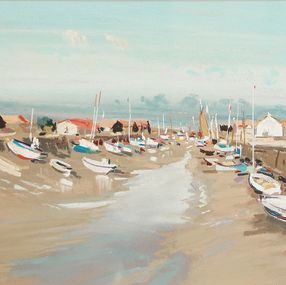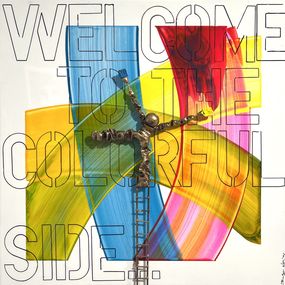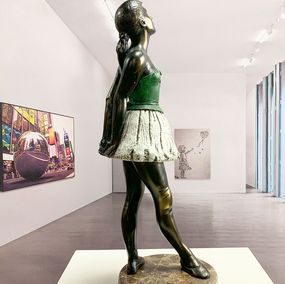
Bronze Sculpture for Sale
Save your search and find it in your favorites
Save your search to find it quickly
Saved search
Your search is accessible from the favorites tab > My favorite searches
Unsaved search
A problem occurred





Love-large size
Muraz Martirosyan
Sculpture - 59 x 18 x 13 cm Sculpture - 23.2 x 7.1 x 5.1 inch
$5,219

The little self made man
Víctor Hugo Yáñez Piña
Sculpture - 27 x 13 x 11 cm Sculpture - 10.6 x 5.1 x 4.3 inch
$5,567



Pegasus
Alexandra Kapogianni-Beth
Sculpture - 32 x 40 x 26 cm Sculpture - 12.6 x 15.7 x 10.2 inch
$5,764





Petite femme enceinte 1
Carl Jaunay
Sculpture - 17 x 14 x 9 cm Sculpture - 6.7 x 5.5 x 3.5 inch
$452

Méditation - série corps de femme nu
Chantal Molinié Jonquet
Sculpture - 22 x 16 x 16 cm Sculpture - 8.7 x 6.3 x 6.3 inch
$2,754

Réflexion - série corps de femme nu
Chantal Molinié Jonquet
Sculpture - 26 x 15 x 25 cm Sculpture - 10.2 x 5.9 x 9.8 inch
$3,624

Affliction - série corps de femme nu
Chantal Molinié Jonquet
Sculpture - 22 x 18 x 21 cm Sculpture - 8.7 x 7.1 x 8.3 inch
$5,219





Ondine série corps de femme
Chantal Molinié Jonquet
Sculpture - 11 x 48 x 21 cm Sculpture - 4.3 x 18.9 x 8.3 inch
$4,593

Désinvolte série corps de femme
Chantal Molinié Jonquet
Sculpture - 44 x 19 x 29 cm Sculpture - 17.3 x 7.5 x 11.4 inch
$5,335

La conquérante série corps de femme
Chantal Molinié Jonquet
Sculpture - 33 x 45 x 20 cm Sculpture - 13 x 17.7 x 7.9 inch
$5,219

Repos série corps d'homme
Chantal Molinié Jonquet
Sculpture - 21 x 14 x 17 cm Sculpture - 8.3 x 5.5 x 6.7 inch
$2,667

Petite affirmation série corps de femme
Chantal Molinié Jonquet
Sculpture - 23 x 19 x 15 cm Sculpture - 9.1 x 7.5 x 5.9 inch
$2,667

Je suis parce que nous sommes
Claude Justamon
Sculpture - 80 x 57 x 34 cm Sculpture - 31.5 x 22.4 x 13.4 inch
$19,948



Sur le rocher
Jacques Coquillay
Sculpture - 43 x 54 x 18 cm Sculpture - 16.9 x 21.3 x 7.1 inch
$12,178





La photo de famille avec le chien
Marie-Madeleine Gautier
Sculpture - 19 x 7 x 7 cm Sculpture - 7.5 x 2.8 x 2.8 inch
$2,436


La grandre chaumière
Alberto Ascaso
Sculpture - 104 x 20 x 40 cm Sculpture - 40.9 x 7.9 x 15.7 inch
$17,397



Angel in a wheel
Muraz Martirosyan
Sculpture - 83 x 39 x 26 cm Sculpture - 32.7 x 15.4 x 10.2 inch
$15,077


Una historia de amor 1/8
Alberto Ascaso
Sculpture - 87 x 27 x 10 cm Sculpture - 34.3 x 10.6 x 3.9 inch
$12,178

Jeanne Hebuterne
Alberto Ascaso
Sculpture - 118 x 26 x 26 cm Sculpture - 46.5 x 10.2 x 10.2 inch
$20,876





Les Insouciantes 7/8
Marie-Madeleine Vitrolles
Sculpture - 25 x 23 x 50 cm Sculpture - 9.8 x 9.1 x 19.7 inch
$4,175


La Vie
Merry Kerpitchian (Merry K)
Sculpture - 50 x 40 x 30 cm Sculpture - 19.7 x 15.7 x 11.8 inch
$6,727



Mademoiselle A
Antoniucci Volti
Sculpture - 34 x 54 x 28 cm Sculpture - 13.4 x 21.3 x 11 inch
$32,474

Looking at the Stars
Anke Birnie
Sculpture - 51 x 24 x 10 cm Sculpture - 20.1 x 9.4 x 3.9 inch
$6,827


Un jour peut-être
Marie-Madeleine Gautier
Sculpture - 56 x 23 x 21 cm Sculpture - 22 x 9.1 x 8.3 inch
$22,036





Lectrice dans ses pensées
Carl Jaunay
Sculpture - 35 x 28 x 33 cm Sculpture - 13.8 x 11 x 13 inch
$4,164

Lectrice main sur genoux série 35
Carl Jaunay
Sculpture - 33 x 23 x 35 cm Sculpture - 13 x 9.1 x 13.8 inch
$4,164

Petite femme enceinte 2
Carl Jaunay
Sculpture - 26 x 9 x 9 cm Sculpture - 10.2 x 3.5 x 3.5 inch
$452
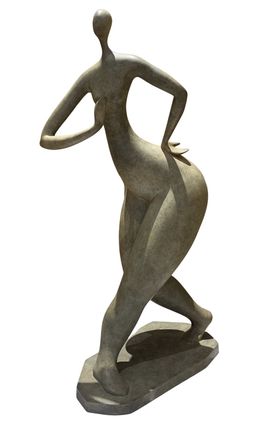
Pantomime
Marie-Madeleine Gautier
Sculpture - 61 x 24 x 36 cm Sculpture - 24 x 9.4 x 14.2 inch
$14,845

Femmes qui lisent sont dangereuses
Marie-Madeleine Gautier
Sculpture - 84 x 46 x 41 cm Sculpture - 33.1 x 18.1 x 16.1 inch
$26,095

Femme assise sur socle
Marie-Madeleine Gautier
Sculpture - 30 x 8 x 11 cm Sculpture - 11.8 x 3.1 x 4.3 inch
$6,727
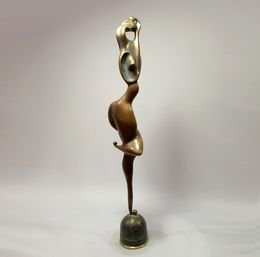





Le Triangle Parfait
Merry Kerpitchian (Merry K)
Sculpture - 12 x 25 x 22 cm Sculpture - 4.7 x 9.8 x 8.7 inch
$4,523

La danseuse
Merry Kerpitchian (Merry K)
Sculpture - 15 x 31 x 11 cm Sculpture - 5.9 x 12.2 x 4.3 inch
$4,349



Stop and focus
Emmanuel Okoro
Sculpture - 95 x 110 x 20 cm Sculpture - 37.4 x 43.3 x 7.9 inch
$5,851





La Grande Valdivienne
Bernard Métranve
Sculpture - 41.5 x 17.5 x 6 cm Sculpture - 16.3 x 6.9 x 2.4 inch
$5,579

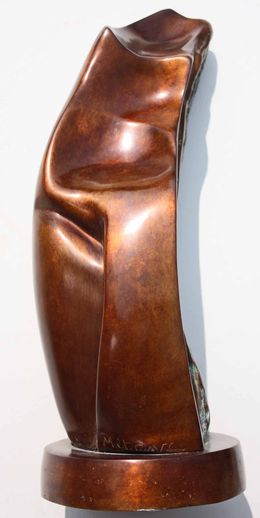

Lectrice sur 4 grimoires Être
Carl Jaunay
Sculpture - 55 x 34 x 23 cm Sculpture - 21.7 x 13.4 x 9.1 inch
$11,366


Atlantias série corps d'homme
Chantal Molinié Jonquet
Sculpture - 64 x 48 x 19 cm Sculpture - 25.2 x 18.9 x 7.5 inch
$6,611





La fuite du cheval Bayard
Edward Vandaele
Sculpture - 130 x 130 x 130 cm Sculpture - 51.2 x 51.2 x 51.2 inch
$68,427


La danse des nymphes - trio 50 cm 4B (1)
Patricia Grangier
Sculpture - 56 x 35 x 20 cm Sculpture - 22 x 13.8 x 7.9 inch
$3,097
Discover the styles & movements
Discover the selection of our experts
Bronze Sculpture for Sale
The technique used in the creation of bronze sculptures has changed very little since Antiquity. The sculptor begins by fashioning the subject in wax, then covers it with clay, pours on the bronze, an alloy of copper and tin, then breaks open the terracotta, leaving only the bronze object behind. Highly valued by sculptors, bronze is a robust and resistant material that fairs well outside. Using wax to create the initial mould allows for a high level of detail on the final sculpture, unlike steel sculpture. Certain nuances in color can be produced through the use of patinas.
These qualities explain why bronze is one of the oldest materials to be used by humans. Indeed, bronze tools were used in Mesopotamia, Egypt and China around 2800 BC.
In Mesopotamia, near to present-day Iran, bronze was used to depict animals in sacred art. In Egypt, it was was used to personify the gods, and also to create small sculpture statues placed in the tombs of the deceased. However, it was Ancient Greece, where craftsmen began to sculpt human figures and deities with remarkable realism, that gave bronze its prominent place in the history of art. Many pieces of work were imported to Rome, where the production of bronze sculptures developed. Bronze sculptures soon began to decorate the theatres and the homes of the rich. Admiring the skills of the Greeks, the Romans began ordering sculptures from merchants and craftsmen, who made copies of the moulds of the statues.
With the birth of Christianity, evangelisation and the building of churches became the priorities, and bronze creations were replaced by stone sculptures for decorating churches. It was only in the 14th century that masterpieces were rediscovered during excavations of Italian archaeological sites. A century later, Brunelleschi and Ghiberti set the Renaissance in motion by decorating the doors of the Florence Baptistery in bronze. Donatello, inspired by ancient Roman sculpture, was the first to excel in the art of expressing emotions through bronze sculptures, followed by Verrocchio, his pupil (and master of Leonardo da Vinci). Although the practice spread throughout Europe, it was mainly focused in Italy, where sculptors competed to obtain the most convincing results.
During the 16th century, the Flemish Jean de Bologne established himself as the undisputed master of bronze. He was the most copied artist in the 17th century, and it is partly due to him that the bronze sculpture spread across Europe. In Italy, production of bronze sculpture was fairly constant, irrespective of the period. In France, on the other hand, this technique depended on the political regime. When Louis XIV invited sculptors to his court (essentially to decorate Versailles) demand for bronze reappeared as a form of courtly art.
Bronze sculpture underwent a resurgence during the 19th century, with Rodin and Camille Claudel, and then with Cubism and the Art Deco movement. Bronze is an expensive, heavy material and costly for collectors to buy and its use has become less prevalent in the 20th and 21st centuries, but some artists use it nonetheless: Giuseppe Penone, Alberto Giacometti with his strange silhouettes, the compressions of César Baldaccini, Philippe Pasqua's butterflies and still life sculpture can all be seen on Artsper!
Bronze sculptures are made from a series of wax molds, into which the sculptor pours melted bronze to create the final sculpture.
Bronze is used for sculptures because it expands just before it hardens, resulting in the accentuation of fine details. The bronze then shrinks slightly as it cools down, which makes it easy to remove the cast.
You can tell if a sculpture is bronze by testing if a magnet sticks to it, as iron is magnetic. Bronze also does not have the ability to rust, so a bronze sculpture will not have signs of corrosion on its surface.




















